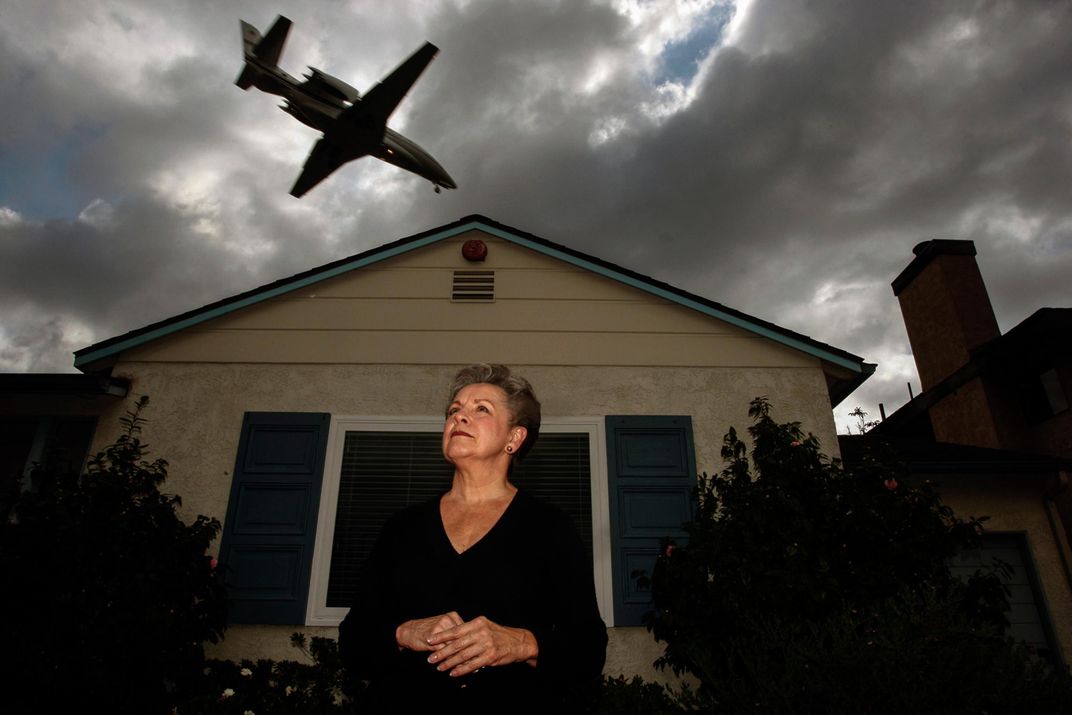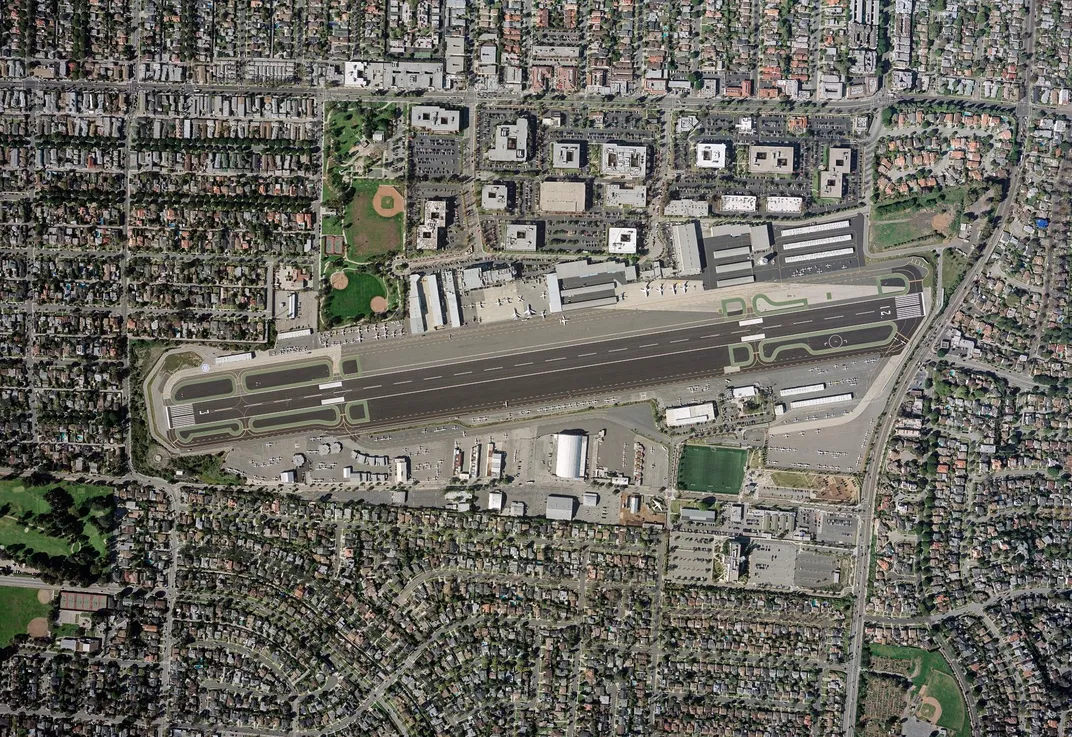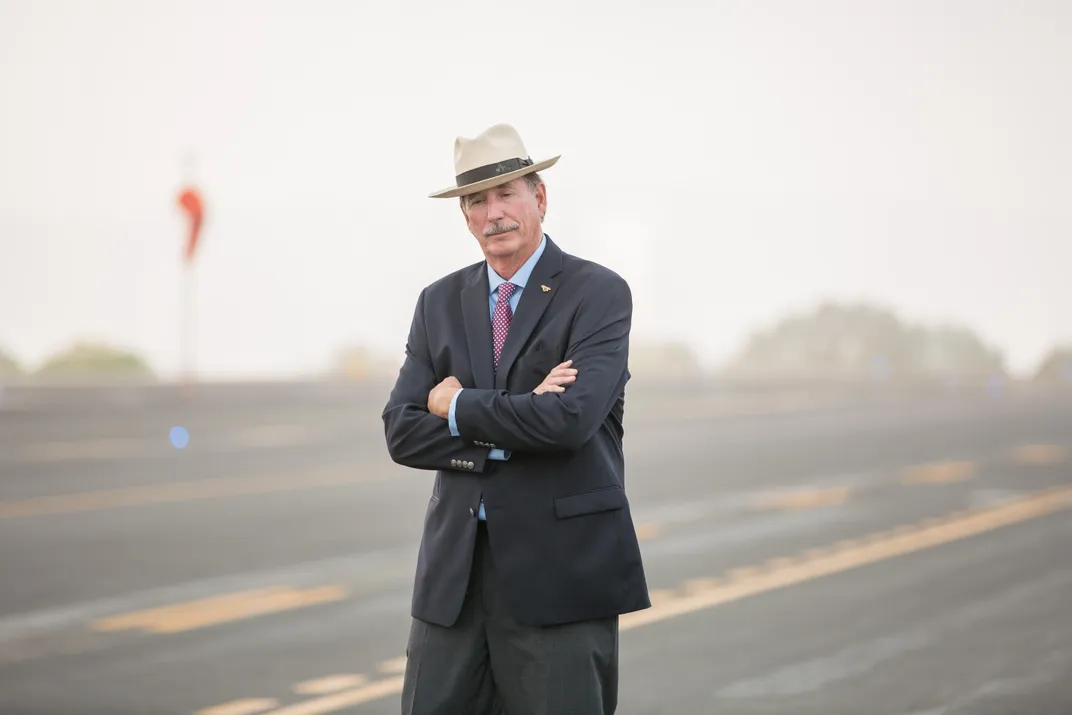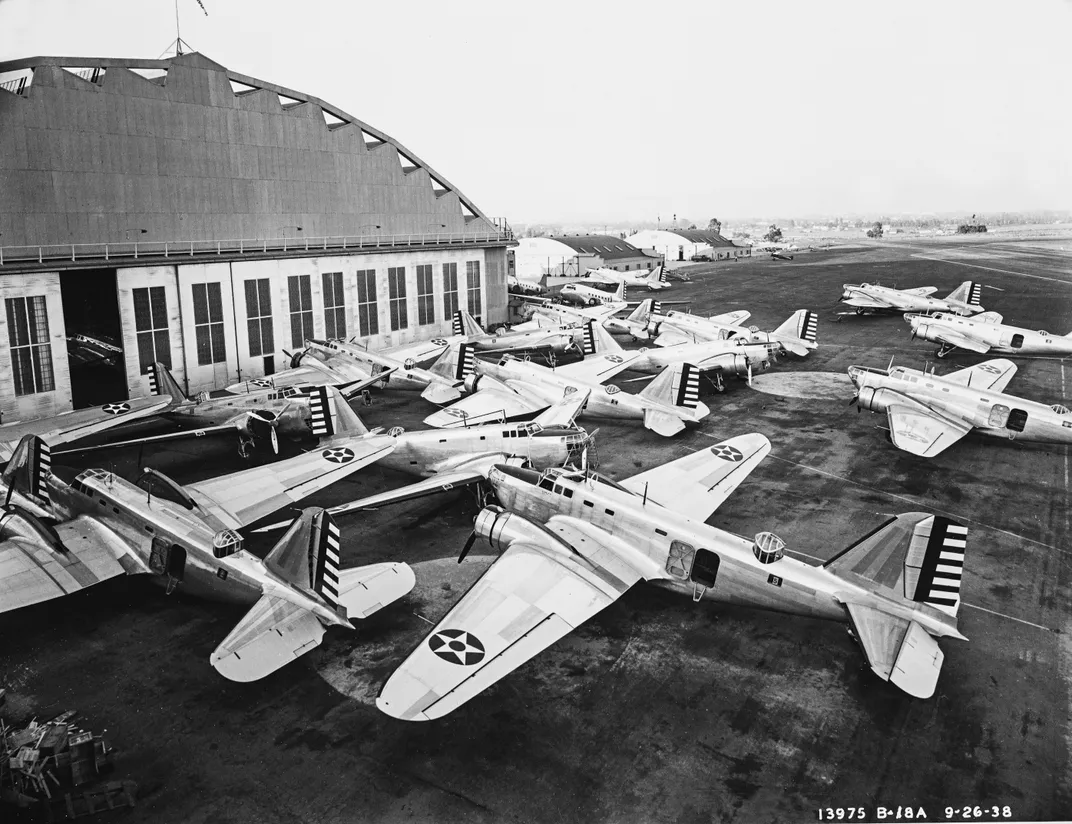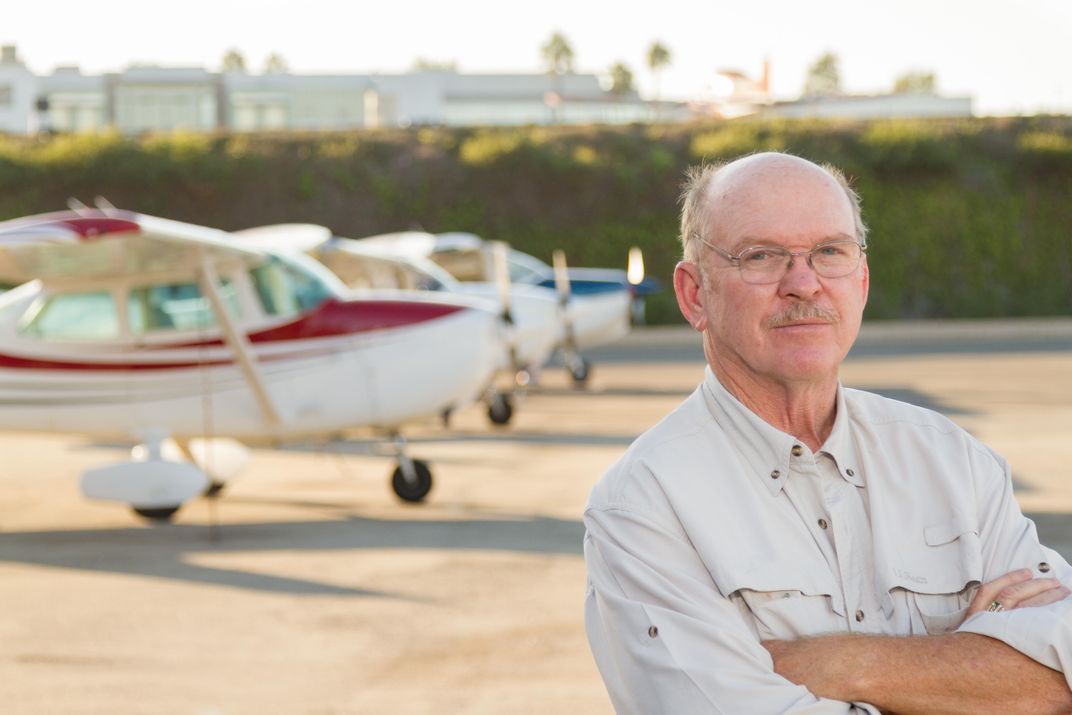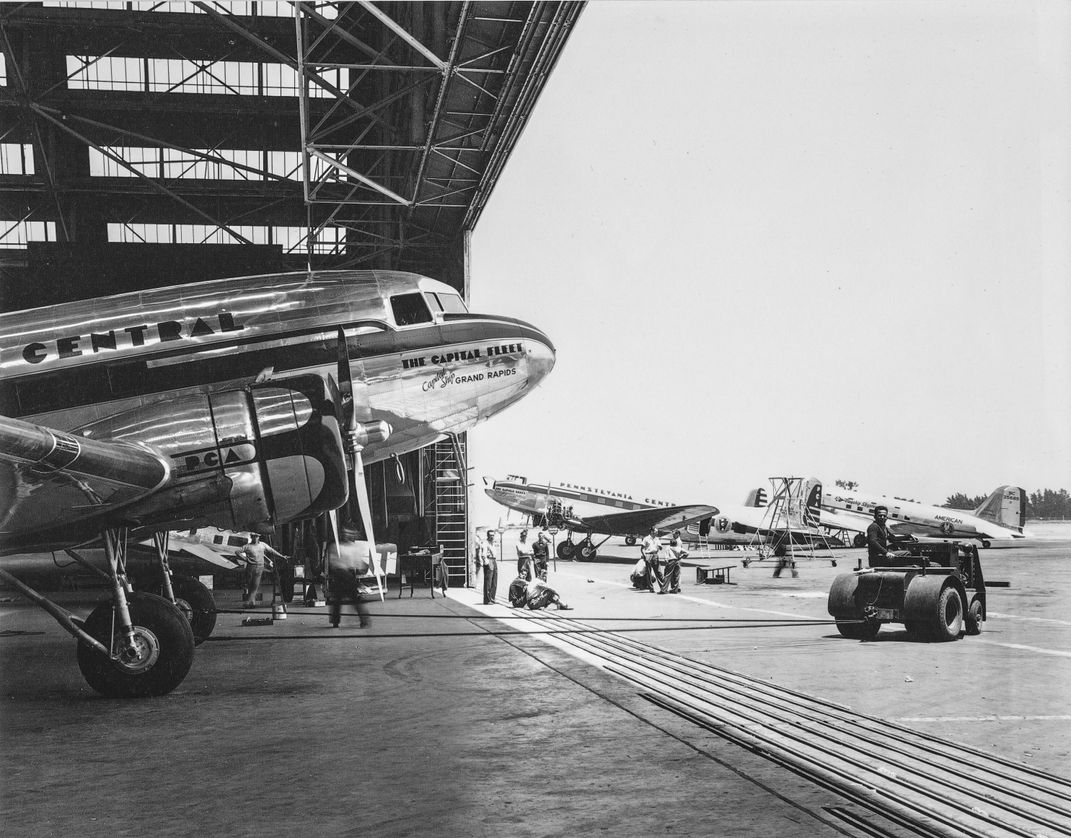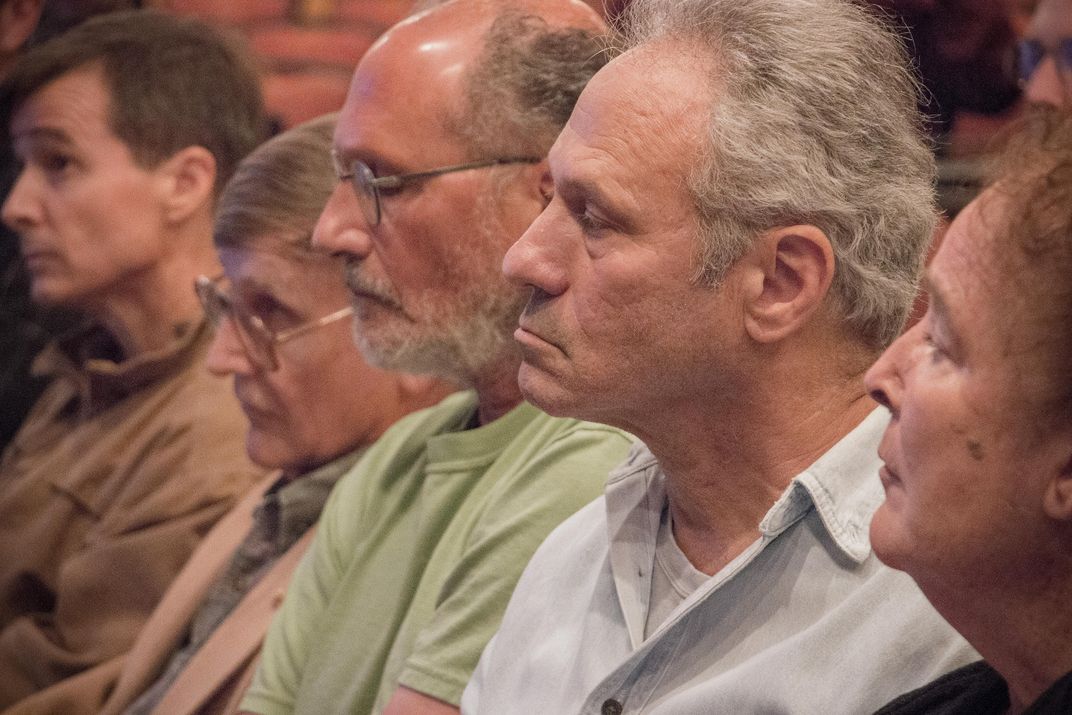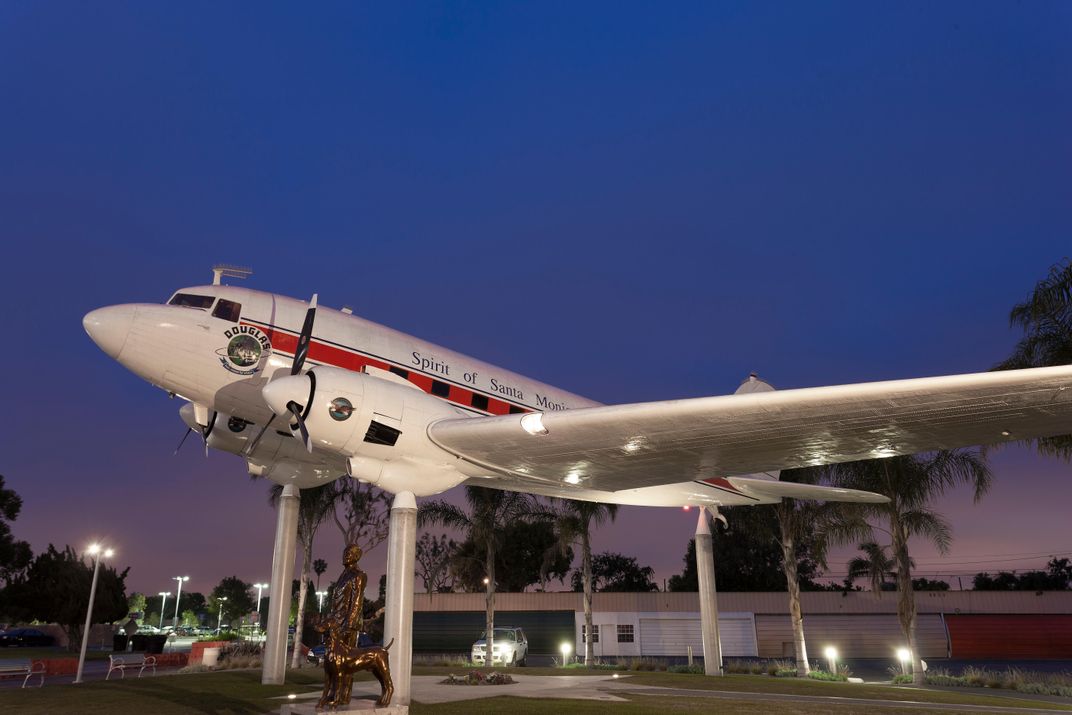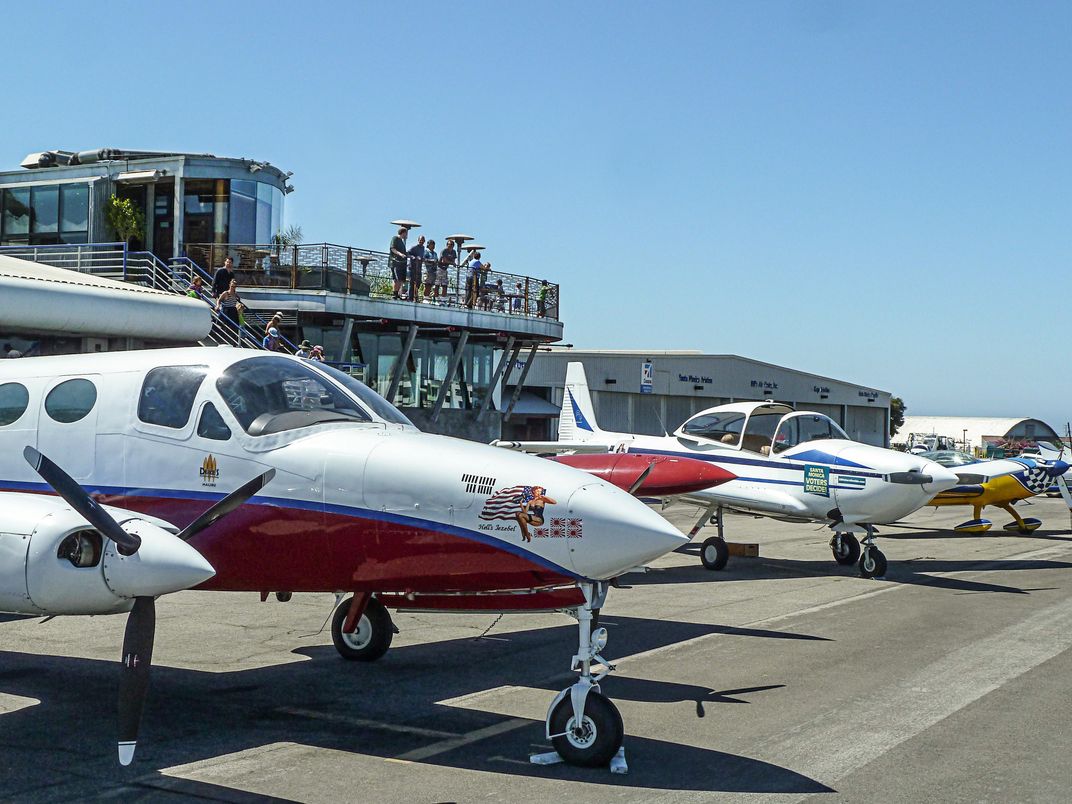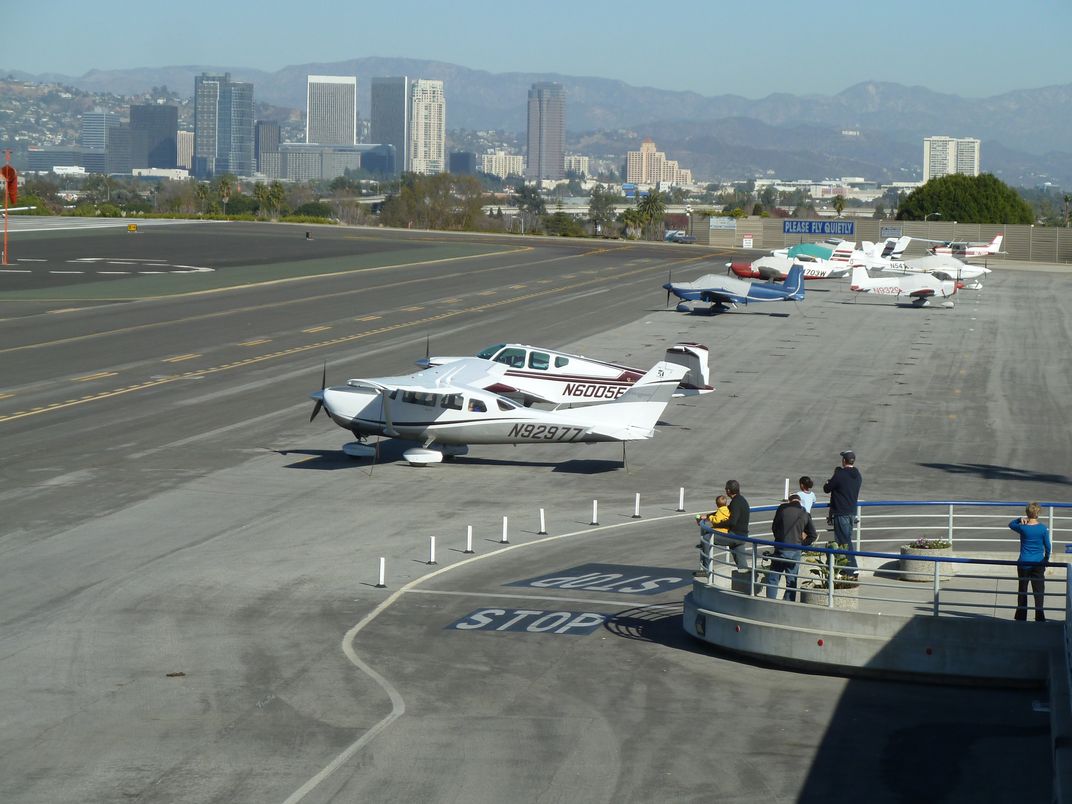Can This Airport Be Saved?
The fight over one of the nation’s busiest single-runway general aviation airports
/https://tf-cmsv2-smithsonianmag-media.s3.amazonaws.com/filer/fd/f5/fdf5095c-f243-4a71-ad36-4a0ca370a191/06w_on2014_opener_live.jpg)
On a hot afternoon in August 1945, the voice of Donald Douglas boomed over loudspeakers in the cavernous assembly buildings of the Douglas Aircraft Corporation at California’s Santa Monica Airport. All up and down the queues of C-47 Gooney Birds and A-26 Invaders, rivet guns and impact wrenches fell silent as Douglas informed the first shift that World War II was over. Japan had surrendered. “We all put down our tools and streamed out onto Ocean Park Boulevard, laughing and singing and hugging each other,” one employee recalled in a book on the manufacturer. Like many Douglas workers who lived in neighborhoods surrounding the airport, she hurried home and later celebrated through the night at the Santa Monica pier with most of the city. That was then.
This is now. On an early afternoon in February, ocean mist throws the view from the Santa Monica Airport observation deck into soft focus. Martin Rubin gestures out across the runway and hangars. “It’s outrageous that this city touts itself to be such an environmentally friendly place,” he says, “yet they won’t even touch this catastrophe.” Rubin, founder of Concerned Residents Against Airport Pollution (CRAAP), is the chief organizer of anti-airport activism in Santa Monica and west Los Angeles, an area comprising numerous neighborhood groups coalesced around long-simmering grievances against the 90-year-old facility. When I ask if his goal is to shut down Santa Monica Airport, Rubin doesn’t hesitate. “It didn’t start out that way,” he says flatly. “But it is now.”
A barley field once occupied what became Santa Monica Airport, and while nobody’s sure when the first airplane set down here, by 1917 biplanes were using the field as an informal landing strip. Donald Douglas arrived in Santa Monica in 1921 and began test flying his first military airplanes, built in an abandoned silent movie studio on nearby Wilshire Boulevard. In 1923, the strip was officially named Clover Field (in honor of World War I pilot and local native Greayer “Grubby” Clover). Howard Hughes learned to fly here. Amelia Earhart tied down here. The first round-the-world flight originated here, and Bill Lear, father of the Learjet, built his first manufacturing facility here. Now more than 200 acres on a bluff overlooking the city and the blue Pacific Ocean, Santa Monica Airport (SMO) is among America’s busiest single-runway general aviation airports and a crucial rest stop for the busy skies of greater Los Angeles. Yet next year, decisions at the local and federal levels may drastically curtail operations at the historic facility, or close it down completely.
To build the DC-3, which transformed the aircraft and air travel industries overnight, workers flocked here by the thousands. In the dire 1930s economy, Douglas Aircraft provided steady jobs. “The DC-3 really saved Santa Monica from the Depression,” says historian and author Paula Scott. The factory soon became the focus of Santa Monica’s local economy and culture. “Douglas was what the whole town was doing,” Scott says.
During World War II, Douglas mass-produced the A-20 and A-26 light bombers and the C-47 military variant of the DC-3. As many as 40,000 workers built airplanes in three shifts around the clock. As C-47s rolled off the line, 1,800-horsepower radial engines rattled the neighborhood day and night. Oily exhaust mingled with ocean fog in nearby streets. When America flew to war in machines built at Santa Monica, no one complained about airport noise or pollution.
Donald Douglas would scarcely recognize the homes he had built for his blue-collar workers. Houses once occupied by assembly line workers today draw appraisals exceeding $1 million. The neighborhoods have become gentrified; on a street where residents kept horses or chickens in back yards as late as the 1960s, an empty lot now brings $700,000.
Next door, SMO handles 165,000 landings and takeoffs annually, of which about 14,000 are business jets. Of the 262 airplanes based here, all but 40 are single-engine, propeller-driven.
“You like that smell?” Rubin asks. “That’s what got me involved.” We’re in the North Westdale neighborhood of Mar Vista, just off the east end of SMO, not far from Rubin’s home and the vegetable garden he was weeding the day he got fed up. The air is heavy with the odor of burning jet fuel. No major airport in the United States is as intimate with its neighbors as Santa Monica; as little as 250 feet separates living room Barcaloungers from Bombardier jets landing at 140 mph. “I’ve given up using my back yard,” says Virginia Ernst, a longtime resident and prominent airport critic. In Ernst’s home on Sardis Avenue, I leave my shoes at the door and sit on her sofa as she describes life under the landing path in the house she’s owned for over 50 years. “To be honest with you,” she says right off, “I hate the jets.” Ernst interacts with Federal Aviation Administration officials frequently, “and not one has ever told me this is a good situation. But the FAA’s point of view is that our homes are too close to the airport, not that the airport’s too close to our homes.”
She synchronizes a pause with the shriek of a jet passing overhead—a reflex obviously refined from years of interrupted conversations. My reflex is to duck. “They’re allowed to pass 87 feet above my roof,” she explains, as tires touch tarmac a hundred yards away with a squeal. A connoisseur of jet sounds and smells, Ernst identifies their provenance without even looking. “Challengers are quieter when they’re holding. But when they take off, you get a deep rumbling and the whole house trembles.” Gulfstream’s G4, the largest of the jets allowed at SMO, has a “high-pitched, irritating effect,” she says. “You can hear the vortex as they pass over. Limbs shake and fruit falls off my trees.”
Did these people realize there was an airport in the neighborhood when they bought their houses? The question is a legitimate challenge from the aviation community to airport neighbors everywhere complaining about noise and pollution. Around Santa Monica, at least, this is the answer: Yes. For many, however, today’s SMO is a far cry from the airport they moved next to. “A lot of our residents here moved in during the years of the jet ban,” explains Cathy Larson of the neighborhood group Friends of Sunset Park. Small jets of the 1960s, the Lears and Rockwell Jet Commanders, were notoriously noisy and grossly polluting. Santa Monica imposed curfews on jets in 1967, then banned them completely. A federal judge threw out the ban in 1981, but a downturn in general aviation kept landings and takeoffs low throughout the 1980s—as few as two jet operations per day during some years. Prospective homeowners saw, heard, and smelled a classic prop-driven general aviation facility operating next door. “A good-old-boy type of airport,” Virginia Ernst recalls. “We even added onto our house then because it was so nice here we thought we wanted to stay.”
This harmony of buzzing props and tinkling wind chimes gave way to more discordant sounds. “Powerful business aircraft groups targeted this airport,” Martin Rubin says. Without notifying the neighborhood, the city issued leases to build business-jet centers on the north side of the runway. Office complexes sprang up nearby to draw wealthy Hollywood entertainment tenants. Then came a $10 million runway makeover. By that point, Rubin says, “the increase in jets was just phenomenal.” A few years ago, annual jet operations exceeded 18,500, and neighbors were subjected to as many as 70 jet takeoffs or landings per day. Last year, they accounted for 94 percent of noise violations. “They should never have let jets back into this airport,” Rubin says. “They shouldn’t have been let in to begin with.”
Bob Trimborn, Santa Monica Airport director from 1996 to 2013, occupied the spot between the SMO tarmac and the increasingly virulent Santa Monica City Council. The job got a reputation as one of the hottest seats in general aviation. “Put it this way,” Trimborn tells me about his conversations with other airport managers. “No one ever asked me where Santa Monica is.” As an employee of a city that has only occasionally lent support to its airport, he performed his civic job while walking a tightrope with the feds at the FAA. Stoic and perennially composed, Trimborn stood as a lightning rod for complaints from disgruntled airport neighbors—not to mention Santa Monica’s activists—frequently about issues he wasn’t empowered to remedy. Stelios Makrides, the current airport manager, is in the same boat.
Residents to the west under the departure flight path absorb SMO’s sonic brunt. Cathy Larson says noise is the big issue in Sunset Park, “and a lot of people here feel the jets are the main problem.” Though decibels are measured by monitors 1,500 feet off both ends of the runway, they don’t quantify the subjective aspects of airport noise. “Some people can enjoy a rock concert blasting away,” Bob Trimborn says, “yet when a Cessna 172 flies overhead, it’s upsetting.” He points out that given the half-million residents living within five miles of the airport, the number of noise complaints is relatively small. “Certain people complain a lot and a lot of people never complain,” he says. Anything above 95 decibels triggers the monitors and pulls fines ranging up to $10,000 for multiple violations. Though the standards and penalties are the nation’s toughest, Rubin says noise fines “aren’t a big deal” to high-flying jet occupants. “We’re up against the one percent or one-tenth of one percent of society that uses this airport,” he says. “Are the fines high enough for them? I’ll give you a blanket answer. Hell no.”
During his tenure at SMO, Trimborn instituted changes that include measuring noise not only by level but also by duration, a big contributor to the annoyance factor. He also recommended departing jets alter their climb-out from a steep upward path—which directed more racket toward the rooftops and extended the span of time the airplane was within earshot—to a flatter climb profile at reduced power. “That gets the jets out of the neighborhood’s airspace faster,” Trimborn explains, “with less noise reaching the ground.” As a result, noise violations have been drastically reduced. Still, in 2013, the monitors nailed 126 jets (out of 134 total violations). Ironically, airport rules also exclude large, older prop planes: Despite being designed and built here, even Douglas’ hallowed DC-3 doesn’t get a noise pass.
Santa Monica’s image as a facility where the privileged step from luxury jet to limo makes it a sitting duck for anyone with class envy—even though many of the affected commoners are themselves living in million-dollar homes. Virginia Ernst, who still recalls the late Merv Griffin’s tail number, recites a more current Who’s Who of famous names whose airplanes she’s linked to neighborhood noise and exhaust: “Harrison Ford, Brad Pitt, John Travolta, [Bill] Cosby, [Stephen] Spielberg, [Jeffrey] Katzenberg,” she says. “And David Geffen, definitely.” Another frequent flier received a note from Marty Rubin’s CRAAP organization. “We told Arnold Schwarzenegger to stop flying in and out of here in his Gulfstream G4,” Rubin says. “Never heard back from him. Didn’t expect to.”
But studio heavy hitters, Hollywood uber-agents, and aging action heroes are vastly outnumbered by the abundance of SoCal recreational pilots on a budget, transient private planes, and earnest flight school students. Fractional-ownership company NetJets visits frequently to fly more mundane business travelers, most of whose names you wouldn’t recognize. Medevac helicopters and Lifeguard missions dispatch to medical emergencies and rush transplant organs to UCLA Medical Center, while Angel Flight flies low-income patients in at no cost for specialized health treatment. The airport also hosts the West Coast dealership for Cirrus Aircraft and non-aviation entities like the Volkswagen/Audi design bureau. At night, live jazz is on the menu at the Typhoon Restaurant.
Years ago a backyard fence got flattened by the blast from a Challenger jet running up RPMs with its brakes on. A heavy glass patio table soared away, propelled by the exhaust of a Las Vegas casino tycoon’s $35 million Gulfstream. Belatedly, the airport built a wall on the runway’s east end that now deflects jet blast upward, keeping neighborhood tables on the ground and blocking Virginia Ernst’s camera angle for jet exhaust videos. What residents of North Westdale fear the 14-foot wall can’t do is keep the less visible effects of combustion out of their yards and bedrooms.
Community activists promote the impression of airport-adjacent neighborhoods blanketed by a potpourri of pollution. Actual research, however, reports mainly the presence of ultrafine particles (UFPs) limited to areas immediately to the east. Southern California Air Quality Management District and UCLA tests have failed to detect common combustion-related pollutants, such as carbon monoxide, particulate matter, volatile organic compounds, and carbonyl. Significant ultrafine particles were undetectable “anywhere other than the area directly downwind of the takeoff area,” says Suzanne Paulson of UCLA’s Atmospheric and Oceanic Sciences Department, who headed the most recent survey. Analyzing air samples taken on the north, south, and west sides of SMO, Paulson tells me, “we could not see any indicators that an airport was there.”
A combustion byproduct, ultrafine particles are smaller than 0.1 micron. If inhaled, UFPs may infiltrate the circulatory system and travel to internal organs. Plumes are disgorged by jets spooling up at SMO—also, by the exhaust of the millions of cars and trucks on L.A. freeways, two of which, Interstates 405 and 10, converge less than a mile from the airport. Paulson’s research isolated a minute-by-minute correlation between jet takeoffs at Santa Monica and highly concentrated UFP plumes pushed by the sea breeze at least 765 yards east into North Westdale. The findings seem bulletproof: When the runway closed for four days for resurfacing, UFP spikes flattened and neighborhood levels plunged to what passes for normal, at least by L.A. air standards.
While the particle status east of SMO seems well established, exactly what level of ultrafines constitutes a health hazard is less clear, says Paulson, a Sunset Park homeowner and member of the Santa Monica Airport Commission. “Currently, no regulations govern ultrafine particles in terms of air pollution and health,” she says, noting that the Environmental Protection Agency has not set ultrafine limits for “anything associated with either roadways or airports.” However, Paulson emphasizes that a growing body of research suggests a link between exposure to UFPs from freeways or airports and a range of illnesses. “We’re really just scratching the surface,” she says. More research is under way.
Justice Aviation has trained pilots at Santa Monica for 22 years. Sitting in his office—which shares space with a full-cockpit simulator—Joe Justice radiates an embattled vibe. “There are strong interests that are highly motivated to squeeze this airport out,” Justice says. He quotes two surveys—one by the city and one by the Aircraft Owners and Pilots Association—that indicate the majority of Santa Monicans do not oppose the airport. However, he says, “the minority opposition has organized itself extremely well and now has command of the city council.” The council is vocal about its intent to shut down the airport. “At least you have to give them credit for being honest,” Justice says grimly.
If Santa Monica airport is closed, Justice believes, “the precedent will be set that other airports can be shut down by people around them who don’t want them there. General aviation in the United States will follow the path of what’s happened in Europe, where it’s been literally destroyed.” Justice suspects a larger agenda behind efforts targeting jets. “I used to think, ‘Maybe our neighbors would be happy if the airport was nothing but our propeller aircraft,’ ” he says. But if jets are banned, “the rest of us will not be here very long either. Once it’s just us individual pilots with our small planes, we’ll be crushed by land developers who want this property.” That flight school airplanes emit hazardous lead pollution is an article of faith among Santa Monica airport activists. Unlike automotive fuel, avgas formulated for propeller-driven planes has lead additives (see “The Fight Over Avgas,” Aug. 2013). Living under the flight pattern of small prop planes, some neighbors believe the ground beneath their feet is toxic with lead (the reason Virginia Ernst asked me to remove my shoes before entering her house). Despite these convictions, a Southern California Air Quality Management District representative told State Senator Ted Lieu’s Select Committee on Air Quality in 2011 that the lead levels in soil, dust, and air at and near the airport were all well below the federal cutoff for public safety—including the EPA’s new, more stringent standard. The lead gradient declines exponentially the further samples are taken from the runway. Even smack on the tarmac, lead levels barely exceed one-half the permissible standard.
“The EPA says in its report there’s more hazard from lead contamination due to products in the home than what this airport’s producing,” Justice says. He believes the opposition’s current focus on lead from propeller aircraft is just a Plan B resorted to after the latest jet ban effort flopped in federal court. “So now they’re claiming, ‘Wait, the real problem here is actually these little flight school planes.’ ”
Ted Lieu’s constituency includes neighborhoods around Santa Monica airport. “If only I had 20/20 vision,” he says, “I’d have been an Air Force pilot.” As a lieutenant colonel in the Air Force Reserves, Lieu still has aviation cred. “I love airplanes,” he maintains. “I support general aviation. I support community airports. I just don’t support them when they’re in the wrong location.” Today’s Santa Monica is no longer the place for an airport, Lieu believes.
“In my opinion, the FAA doesn’t care at all about the residents surrounding Santa Monica Airport,” Lieu tells me. “The FAA’s primary mission is to keep as many airports open as possible and as many planes in the air as possible.” In his role as chair of the state senate’s air quality committee, Lieu has heard hours of testimony from neighbors concerned about SMO. He doesn’t soft-peddle his own opinion about what should happen in 2015: “I strongly believe the city of Santa Monica should not renew the lease for that airport. It’s the city’s land, and the FAA can’t force them to do something with it they don’t want to.”
As a former prosecutor in the Judge Advocate General Corps, Lieu probably knows that’s a long way from a slam-dunk. What muddles SMO’s future is a tangled web of agreements undertaken with the federal government from World War II on—some in jittery, old-typewriter font, signed by long-dead officials. Airport turf is divided into three parcels, each controlled by one or more agreements between the city and the FAA. Taken literally, the 1948 Instrument of Transfer requires the city to operate a 3,000-foot runway indefinitely—or let the federal government do so. Since the present runway totals 5,000 feet, it’s the westernmost 2,000 feet that’s in the most immediate limbo, along with the support facilities alongside it. But that span spells the difference between a jet-worthy runway and one accommodating only small prop planes. Santa Monica City Attorney Marsha Moutrie believes the city could amputate that end of the runway at will, since it’s not among the issues included in the Instrument of Transfer that expires in July 2015. She also expects any city attempt to do so will “likely provoke a complaint by the FAA and the aviation community,” leading to yet another legal skirmish with the agency. Despite the recent bruising it took in federal court, on March 25 the Santa Monica city council voted 6 to 0 to support an Airport Concept Plan for SMO downsizing, including closure of the western span of runway and termination of leases to flight schools occupying adjacent land. Or not. Lawyers for the Aircraft Owners and Pilots Association and the National Business Aviation Association dispute point by point Santa Monica’s assertions, emphasizing among many other issues that the city’s acceptance of federal improvement funds in 2003 legally compels it to continue operating all 5,000 feet of runway and associated services until at least 2023. Where the federal government will come down on these issues remains unknown, and the FAA’s silence has only fueled speculation.
Unseen others may have designs on what would be L.A.’s last large piece of prime real estate. “The dirt here is very valuable,” Bill Worden says one Saturday afternoon in the clamor of the airport’s Spitfire Grill. “People are scheming on it all the time.” Worden’s a pilot and Venice, California native who grew up close enough to watch takeoffs and landings from backyard trees he climbed. He cofounded the SMO Angel Flight chapter once headed Air Care Alliance, an umbrella group representing organizations that make charity medical flights. He’s also the head of the airport’s local advocacy organization.
Worden says he has a reality check for local activists penciling in hiking trails where hangars now stand: Vacated airport real estate worth billions will not be converted to pristine parkland that generates zero tax revenue. “There’s any number of development interests that would like to build in this part of the world, but they’re not going to tell us about it,” he says. “We have hearsay information from a couple of conversations that the city already has a plan for some of the residual land, but nobody will admit to it. It’s speculation, I have nothing hard. But I guarantee something’s there.”
The artificial ceiling imposed for safety reasons by the FAA prohibits tall buildings anywhere near the airport, a restriction that, if lifted, would likely result in more road traffic and consequent congestion and pollution. Indeed, the question of what might replace the airport has some neighbors uneasy. “The only thing that draws more complaints here in Sunset Park than the airport is the idea of increasing traffic,” says Cathy Larson. “A lot of people have voiced that they do not want big development to come into this area.”
“What we’re trying to get across to these people,” Worden says, “is that if this airport closes, they are not going to get Sequoia or the world’s largest dog park in its place. They’re going to get Century City and everything that goes with it—whether they want it or not.”
As for the status quo, only a lawyer could love it. Last October, a federal judge dismissed a sweeping lawsuit Santa Monica had filed against the FAA to conclusively establish that the city controlled airport land. City Attorney Marsha Moutrie delivered a prognosis to the city council that downsized visions of airport tarmac being supplanted by flora, fauna, or mixed-use real estate development: “It is now clear that legal disputes about the city’s authority to close the airport will inevitably extend well beyond 2015, and their outcome is uncertain.” After tallying up litigation that could potentially stretch more than a decade, Moutrie listed the virtues of incremental measures to reduce airport size, versus yet another round with the FAA. In June, a petition sponsored by the Aircraft Owners and Pilots Association, the National Business Aviation Association, and the Santa Monica Airport Association easily gathered enough local signatures to qualify a ballot measure for the November election that would require voter approval for any changes to land use at SMO. Says a spokesman for the measure, “Voters will resolve one simple question: Should Santa Monica voters be asked for their approval before politicians, developers, and special interests can convert 227 acres of low-density airport land for their own purposes?”
On a bright Sunday morning at SMO, the argument seems as distant as Catalina Island, mounted like a gem in its blue setting to the south. Parents and kids point and grin from the observation deck as a Cessna 172 settles in from the east and putters toward the flight school hangars. Across the runway, anonymous jets slumber, awaiting passengers who probably don’t live in Sunset Park or North Westdale—where their takeoff will likely be hard to miss. And somewhere in Mar Vista, Martin Rubin tracks airport operations on the PublicVue website, poised to file an e-complaint against the next noise violator.
Meanwhile, in the shade of a DC-3 displayed near the airport entrance, immortalized in bronze, Donald Douglas and his dog Wunderbar watch and wait.
